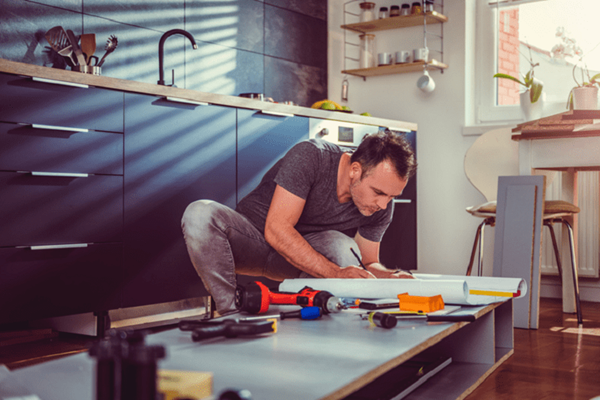Starting a Kitchen Remodel

Preparing and cleaning up after meals and handling groceries can be challenging for stroke survivors. Your typical kitchen routine of reaching, standing, pulling and lifting might not be the same after your stroke. Major improvements in independence are possible after a stroke, and a range of needs can be accommodated with a modified kitchen.
Kitchen modifications can be as simple as installing low-cost adaptations or as extensive as reconfiguring the floor plan and replacing appliances. Many effective modifications won’t cost much or cause too much disruption. Others will require help of a handyperson or even professional expertise.
Accessible Storage
Standard kitchen cabinets are either wall-mounted or under-mounted, requiring you to either reach or bend.
- Remove shelves and replace them with pullout shelves or baskets.
- Lazy Susans make great cabinets fully usable and accessible.
- In a pantry, place most-often-used items on the shelves that are 30 to 54 inches off the floor.
- Some pantry solutions are powered and rotate the shelves down to you, giving you easy access and doubling up your storage space.
Cooking and Baking
- Install a microwave at counter height. Over-the-stove installation makes the microwave harder to reach.
- Use a microwave to reduce cooking time and reduce the risk of using hot appliances.
- Standard stoves/ranges offer limited access to heating elements and controls, especially if you are in a wheelchair. Replace the stove with a separate cooktop and wall oven if possible. A smooth cooktop is easier to keep clean and allows you to slide pans from countertop to burner and back, instead of lifting pans onto and off a burner.
- Wall-mounted ovens can be installed at the height that works best for you.
- Side-opening ovens are available by special order but are more expensive.
Refrigerators
- Side-by-side refrigerators are the most accessible, but they must be positioned so that both doors can be opened fully; otherwise, access will be limited.
- Top-freezer models offer access to the refrigerator for a wheelchair user, but the freezer compartment isn’t accessible. If you have trouble balancing when standing, it might be hard to bend and reach into the refrigerator compartment.
- Bottom-freezer models offer more access to the refrigerator if you’re standing, but people in a wheelchair will have difficulty accessing both the refrigerator and freezer.
- Regardless of configuration, adjustable shelves and pullout shelves optimize accessibility while sitting or standing. Consider a door-mounted ice maker/water dispenser to improve access.
Sinks
- Single-level faucets allow one-handed control of water temperature and pressure.
- Motion activated faucets are touch-free. A wave of the hand, usually over the faucet, turns water on and off.
- Manually set the water temperature and pressure so you don’t have to adjust it each time.
- Consider a pull-out faucet and fill a container or pot on the counter instead of in the sink, eliminating the need to lift the container out.
- If you must access the sink while seated and if you’re the main person using the kitchen, consider removing the cabinets underneath the sink (but still covering the pipes) or even lowering it.
Transfer of Items
Meal preparation involves gathering items from various locations in the kitchen, including pantries, cupboards and refrigerators, and moving them to counters, sinks, ovens and cooktops.
- Place items on the counter and push them from one area to another.
- Consider a small cart to gather items from the refrigerator or pantry.
- A cart can also be helpful for transporting groceries or prepared foods to the table.
Work/Prep Area
Working at a counter can be tiring while standing and difficult while sitting. Create a seated work area for food prep:
- Use pull-out cutting boards or shelves mounted below counter height.
- Place a large cutting board over an open kitchen drawer — creating a temporary work surface for a seated user.
- If you have difficulties in standing for long periods, consider a stool or “standing chair” that will allow you to sit/lean and have support while you’re preparing meals.
- If you perform tasks one-handed, try these tips:
- Use a modified cutting board for chopping.
- Use rubber grip mats under your bowls and cutting boards to keep them securely in place.
- Stock your kitchen with knives with a good rubber grip, rocker knives and manual or electric processors. These are great for cutting, chopping and shredding.
- Use utensils with suction or non-skid/non-slip features.
- Use one-handed jar can and bottle openers.
- Purchase pre-cut or pre-chopped meats and vegetables. Or pre-cut your own ahead of time and store in zip-top bag or airtight storage container for up to a week.
- With today’s technology, many options in kitchen appliances can be controlled with the use of a smart phone/mobile application, smart home assistant or wi-fi.
Read about more home modifications





